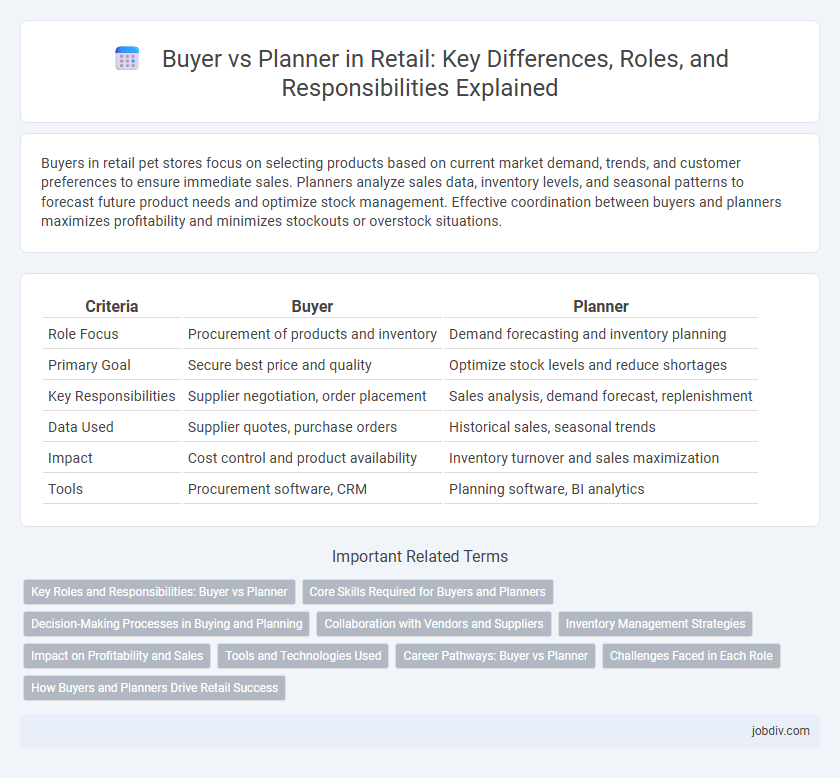Buyers in retail pet stores focus on selecting products based on current market demand, trends, and customer preferences to ensure immediate sales. Planners analyze sales data, inventory levels, and seasonal patterns to forecast future product needs and optimize stock management. Effective coordination between buyers and planners maximizes profitability and minimizes stockouts or overstock situations.
Table of Comparison
| Criteria | Buyer | Planner |
|---|---|---|
| Role Focus | Procurement of products and inventory | Demand forecasting and inventory planning |
| Primary Goal | Secure best price and quality | Optimize stock levels and reduce shortages |
| Key Responsibilities | Supplier negotiation, order placement | Sales analysis, demand forecast, replenishment |
| Data Used | Supplier quotes, purchase orders | Historical sales, seasonal trends |
| Impact | Cost control and product availability | Inventory turnover and sales maximization |
| Tools | Procurement software, CRM | Planning software, BI analytics |
Key Roles and Responsibilities: Buyer vs Planner
Buyers in retail are responsible for selecting and purchasing merchandise, negotiating with suppliers, and ensuring optimal stock levels to meet consumer demand. Planners focus on forecasting sales, analyzing inventory turnover, and developing replenishment strategies to maximize profitability and minimize stockouts. Both roles collaborate closely to align inventory assortment with marketing trends and financial targets.
Core Skills Required for Buyers and Planners
Buyers must excel in negotiation, market analysis, and supplier relationship management to secure competitive pricing and product quality. Planners require strong analytical skills, demand forecasting accuracy, and inventory optimization to maintain efficient stock levels and meet sales targets. Both roles demand proficiency in data interpretation, communication, and strategic decision-making to drive retail performance.
Decision-Making Processes in Buying and Planning
Buyers prioritize immediate procurement decisions based on current market demand, supplier availability, and cost considerations, ensuring inventory levels meet short-term sales targets. Planners analyze historical sales data, forecast trends, and coordinate with multiple departments to develop long-term inventory strategies that optimize stock turnover and minimize holding costs. Effective collaboration between buyers and planners enhances decision-making efficiency, balancing reactive purchasing with proactive inventory management in retail operations.
Collaboration with Vendors and Suppliers
Buyers focus on selecting products that meet market demand while planners analyze inventory levels and forecast sales to optimize stock. Effective collaboration with vendors and suppliers ensures timely delivery and competitive pricing, enhancing supply chain efficiency. Unified communication between buyers and planners with vendors fosters accurate order fulfillment and reduces stockouts or overstock situations.
Inventory Management Strategies
Buyers prioritize selecting products that meet current market demand, ensuring inventory turnover aligns with seasonal trends and consumer preferences to optimize sales. Planners focus on forecasting inventory levels, analyzing sales data, and coordinating replenishment schedules to prevent stockouts and overstock situations. Effective inventory management strategies require seamless collaboration between buyers and planners to balance product assortment with accurate demand forecasting.
Impact on Profitability and Sales
Buyers influence profitability and sales by selecting products that align with consumer demand and optimizing purchase costs, ensuring inventory turnover and margin maximization. Planners drive sales growth and profitability through demand forecasting, inventory allocation, and promotion planning, reducing stockouts and markdowns. Coordinated buyer and planner strategies enhance revenue, minimize excess inventory, and improve overall retail performance.
Tools and Technologies Used
Buyers leverage procurement software and demand forecasting tools to optimize inventory levels and negotiate with suppliers efficiently. Planners utilize advanced analytics, ERP systems, and AI-driven forecasting models to align production schedules with market demand and minimize stockouts. Both roles depend on integrated supply chain management platforms to synchronize purchasing and planning activities, enhancing overall retail operations.
Career Pathways: Buyer vs Planner
Buyers in retail focus on product selection, vendor negotiations, and inventory control, often progressing toward senior buying or category management roles. Planners specialize in demand forecasting, sales analysis, and inventory optimization, with career advancement leading to merchandise planning manager or supply chain leadership positions. Both pathways require strong analytical skills but differ in strategic emphasis--buyers drive product assortment decisions, while planners ensure the right inventory levels to maximize sales and minimize costs.
Challenges Faced in Each Role
Buyers face challenges in demand forecasting inaccuracies, supplier negotiation complexities, and managing inventory turnover to avoid stockouts or overstock situations. Planners struggle with aligning production schedules to fluctuating consumer demand, coordinating cross-functional teams, and optimizing supply chain logistics to ensure timely product availability. Both roles require advanced data analytics and agile decision-making to minimize costs while maximizing customer satisfaction in dynamic retail environments.
How Buyers and Planners Drive Retail Success
Buyers analyze consumer trends and select product assortments that meet market demand, ensuring inventory aligns with customer preferences and maximizes sales potential. Planners optimize financial performance by forecasting sales, managing inventory levels, and setting budget targets to balance supply and demand efficiently. The synergy between Buyers' product expertise and Planners' data-driven strategies drives retail success through improved stock turnover, reduced markdowns, and enhanced profitability.
Buyer vs Planner Infographic

 jobdiv.com
jobdiv.com